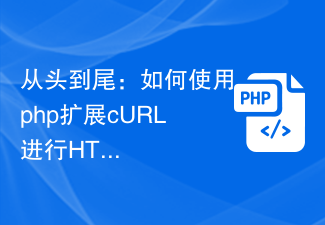In Web development, HTTP request is a very important link. In PHP development, there are many ways to make HTTP requests. One of the more useful ones is to use the Requests library to make requests. This article will introduce how to use Requests in PHP to make HTTP requests.
What is the Requests library?
Requests is a PHP library for HTTP requests. It provides a readable API that allows us to easily send requests containing various parameters and data, while also getting all the request responses. detail.
Why use the Requests library?
Compared with PHP's native curl library, the Requests library provides a more user-friendly and easy-to-use API, allowing us to operate HTTP requests in a concise and intuitive way, while also providing better Error handling capabilities and better readability.
How to install the Requests library?
Installing the Requests library is very simple, you only need to use the Composer tool. Just run the following command:
composer require rmccue/requests
After the installation is complete, we can use the Requests library in the project.
How to use the Requests library to make HTTP requests?
The steps to use the Requests library to send HTTP requests are as follows:
- Introduce the Requests library
At the beginning of the PHP code file, use require_once to introduce the Requests library:
require_once 'vendor/autoload.php';
- Send HTTP request
Use the get, post, put and other methods of the Requests library to send requests, for example:
$response = Requests::get('https://www.baidu.com');In this example, We use the get method to send a request to Baidu's homepage, which will return a response object.
- Get response information
After getting the response, we can get the response status code, header, body and other information, for example:
$status_code = $response->status_code; // 获取状态码 $headers = $response->headers; // 获取响应头信息 $body = $response->body; // 获取响应体信息
- Handling error messages
During the process of sending HTTP requests, some errors may occur, such as DNS resolution errors, connection timeouts, etc. The Requests library provides a complete error handling mechanism. We can use try-catch statements to handle these errors, for example:
try {
$response = Requests::get('https://www.notexistdomain.com');
} catch (Requests_Exception $e) {
echo 'Error: ' . $e->getMessage();
}In this example, we use try-catch statements when sending requests, capturing Possible exceptions (Requests_Exception), and exception information is output.
- Send POST request
The steps to send a POST request using the Requests library are as follows:
$data = array('name' => 'test', 'age' => 18);
$headers = array('Content-Type' => 'application/json');
$response = Requests::post('http://example.com/api', $headers, json_encode($data));In this example, we use the post method to send a POST request to http://example.com/api, the request parameter is $data, the request header is $headers, and the parameters are converted into json format as the request body.
Summary
This article introduces how to use the Requests library to make HTTP requests in PHP, including installing the Requests library, sending requests, obtaining response information, handling error information, and sending POST requests. By using the Requests library, we can complete HTTP request-related operations more conveniently and quickly, improving the efficiency of Web development.
The above is the detailed content of How does php use Requests to make HTTP requests?. For more information, please follow other related articles on the PHP Chinese website!
 PHP使用HTTP请求发送邮件的方法May 21, 2023 pm 07:10 PM
PHP使用HTTP请求发送邮件的方法May 21, 2023 pm 07:10 PMPHP是一种广泛使用的编程语言,其中一个常见的应用就是发送电子邮件。在这篇文章中,我们将讨论如何使用HTTP请求发送邮件。我们将从以下几个方面来介绍这个主题:什么是HTTP请求发送邮件的基本原理使用PHP发送HTTP请求发送邮件的示例代码什么是HTTP请求HTTP请求是指发送到web服务器的请求,以获取web资源。HTTP是一种协议,用于在web浏览器和we
 如何解决Java开发中的HTTP请求连接被拒绝问题Jun 29, 2023 pm 02:29 PM
如何解决Java开发中的HTTP请求连接被拒绝问题Jun 29, 2023 pm 02:29 PM如何解决Java开发中的HTTP请求连接被拒绝问题在进行Java开发中,经常会遇到HTTP请求连接被拒绝的问题。这种问题的出现可能是由于服务器端限制了访问权限,或是网络防火墙阻止了HTTP请求的访问。解决这个问题需要对代码和环境进行一些调整。本文将介绍几种常见的解决方法。检查网络连接和服务器状态首先,确认你的网络连接是正常的,可以尝试访问其他的网站或服务,看
 从头到尾:如何使用php扩展cURL进行HTTP请求Jul 29, 2023 pm 05:07 PM
从头到尾:如何使用php扩展cURL进行HTTP请求Jul 29, 2023 pm 05:07 PM从头到尾:如何使用php扩展cURL进行HTTP请求引言:在Web开发中,经常需要与第三方API或其他远程服务器进行通信。而使用cURL进行HTTP请求是一种常见而强大的方式。本文将介绍如何使用php扩展cURL来执行HTTP请求,并提供一些实用的代码示例。一、准备工作首先,确保php已安装cURL扩展。可以在命令行执行php-m|grepcurl查
 如何使用Nginx进行HTTP请求的压缩和解压缩Aug 02, 2023 am 10:09 AM
如何使用Nginx进行HTTP请求的压缩和解压缩Aug 02, 2023 am 10:09 AM如何使用Nginx进行HTTP请求的压缩和解压缩Nginx是一款高性能的Web服务器和反向代理服务器,其功能强大且灵活。在处理HTTP请求时,可以使用Nginx提供的gzip和gunzip模块对请求进行压缩和解压缩,以减小数据传输量,提高请求响应速度。本文将介绍如何使用Nginx进行HTTP请求的压缩和解压缩的具体步骤,并提供相应的代码示例。配置gzip模块
 Nginx如何实现HTTP请求的重试配置Nov 08, 2023 pm 04:47 PM
Nginx如何实现HTTP请求的重试配置Nov 08, 2023 pm 04:47 PMNginx如何实现HTTP请求的重试配置,需要具体代码示例Nginx是一款非常流行的开源反向代理服务器,它拥有强大的功能和灵活的配置选项,可以用来实现HTTP请求的重试配置。在网络通信中,由于各种原因,例如网络延迟、服务器负载等,有时候我们发起的HTTP请求可能会失败。为了提高应用程序的可靠性和稳定性,我们可能需要在请求失败时进行重试。下面将介绍如何使用Ng
 使用Java 11中的HttpClient发送HTTP请求并处理响应Aug 01, 2023 am 11:48 AM
使用Java 11中的HttpClient发送HTTP请求并处理响应Aug 01, 2023 am 11:48 AM标题:使用Java11中的HttpClient发送HTTP请求并处理响应引言:在现代的互联网应用程序中,与其他服务器进行HTTP通信是非常常见的任务。Java提供了一些内置的工具,可以帮助我们实现这一目标,其中最新且推荐使用的是Java11中引入的HttpClient类。本文将介绍如何使用Java11中的HttpClient发送HTTP请求并处理响应,
 如何使用golang中的http.Client进行HTTP请求的高级操作Nov 18, 2023 am 11:37 AM
如何使用golang中的http.Client进行HTTP请求的高级操作Nov 18, 2023 am 11:37 AM如何使用golang中的http.Client进行HTTP请求的高级操作引言:在现代开发中,HTTP请求是不可避免的一部分。golang提供了强大的标准库,其中包含了http包。http包提供了http.Client结构体,用于发送HTTP请求和接收HTTP响应。在本文中,我们将探讨如何使用http.Client进行HTTP请求的高级操作,并提供具体的代码示
 Nginx如何实现HTTP请求的缓存控制配置Nov 08, 2023 am 09:35 AM
Nginx如何实现HTTP请求的缓存控制配置Nov 08, 2023 am 09:35 AMNginx如何实现HTTP请求的缓存控制配置Nginx作为一款高性能的Web服务器和反向代理服务器,拥有强大的缓存管理和控制功能,可以通过配置实现对HTTP请求的缓存控制。本文将针对Nginx如何实现HTTP请求的缓存控制配置进行详细介绍,并提供具体的代码示例。一、Nginx缓存配置概述Nginx的缓存配置主要通过proxy_cache模块实现,该模块提供了


Hot AI Tools

Undresser.AI Undress
AI-powered app for creating realistic nude photos

AI Clothes Remover
Online AI tool for removing clothes from photos.

Undress AI Tool
Undress images for free

Clothoff.io
AI clothes remover

AI Hentai Generator
Generate AI Hentai for free.

Hot Article

Hot Tools

Notepad++7.3.1
Easy-to-use and free code editor

PhpStorm Mac version
The latest (2018.2.1) professional PHP integrated development tool

SublimeText3 Mac version
God-level code editing software (SublimeText3)

EditPlus Chinese cracked version
Small size, syntax highlighting, does not support code prompt function

mPDF
mPDF is a PHP library that can generate PDF files from UTF-8 encoded HTML. The original author, Ian Back, wrote mPDF to output PDF files "on the fly" from his website and handle different languages. It is slower than original scripts like HTML2FPDF and produces larger files when using Unicode fonts, but supports CSS styles etc. and has a lot of enhancements. Supports almost all languages, including RTL (Arabic and Hebrew) and CJK (Chinese, Japanese and Korean). Supports nested block-level elements (such as P, DIV),





